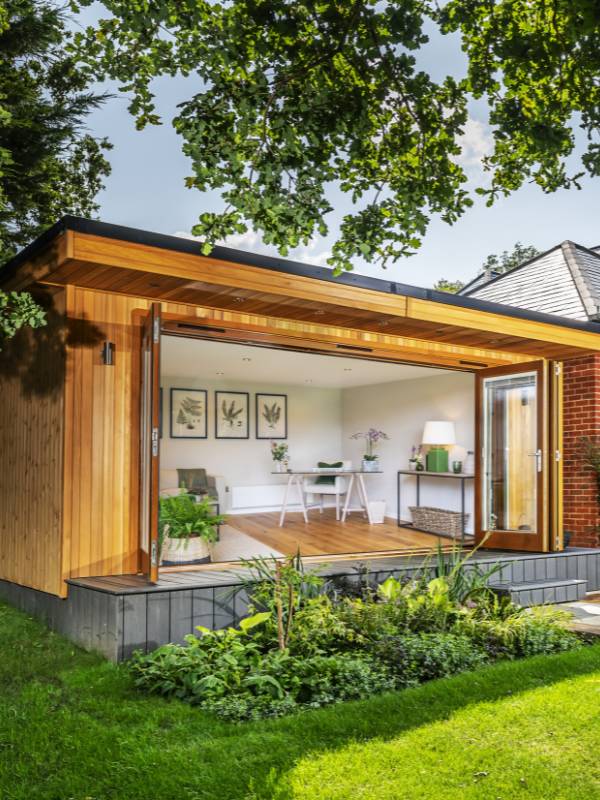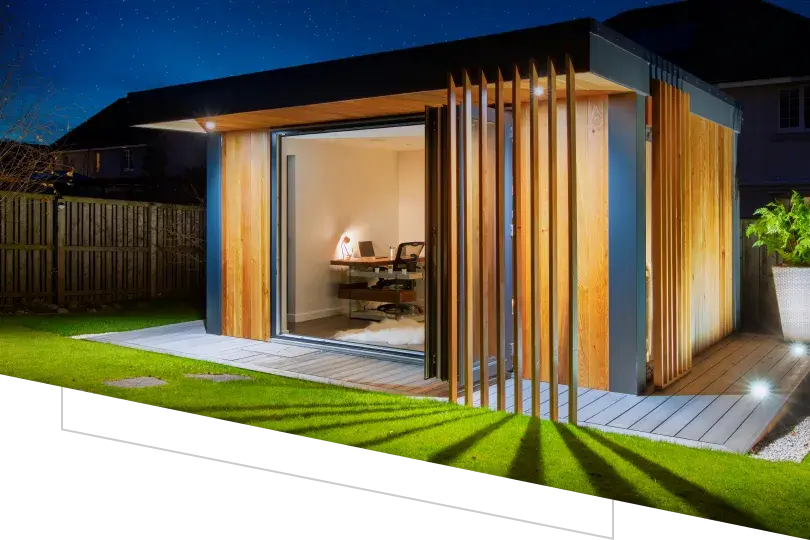Top Info On Planning Permission On Garden Extension
Wiki Article
What Planning Permissions Are Required For Gardens, Rooms, Etc. Regarding Changes Of Use?
When determining whether planning permission is needed for garden rooms or conservatories or outhouses as well as garden offices, or extension, "change of use", also known as "change of purpose" is a crucial role. The planning permission is needed for any changes in use.
A planning permit is required when you're converting a non-residential space (like an agricultural garage or building) to an office space in the garden or a living space. This is because any change to the use of the structure will be necessary.
Garden Rooms: Living Space
It's considered to be a "change of use" when you convert an existing garden into an independent dwelling like an apartment for guests. The building must be permitted for planning to ensure that the construction conforms to requirements for residential properties and standards.
Business Use
If you intend to utilize the garden space, conservatory, or extension for business purposes (e.g. use it as a workplace for an office-based business at home that has frequent visitors or employees) Planning permission may be required. It's because of the impact it will affect the neighborhood like traffic noise, parking and other.
Use in Education or the Community:
Planning permission is required to transform a garden structure into a space for education or for community (such as a meeting room or classroom). The local authorities will evaluate the viability of the site as well as the impact on the area around it.
Impact on Local Infrastructure
Planning permission is usually required for any alteration in usage which has a significant impact on local infrastructure, e.g. roads drainage, public services, and so on. The local planning authority will review the impact of these changes as part the application process.
Dual Use
For properties that will have mixed uses (such as commercial or residential properties that are part-commercial and part-residential) Planning permission is typically required to define and control the different functions within the property.
Increased footfall and traffic:
If the proposed change in usage could result in increased traffic or the number of people that use the area (e.g. changing a garden area into a shop), planning approval is required to limit the effect on the surrounding areas.
Building Regulations conformity:
Although not strictly an issue planning permissions, any alteration in use must adhere to construction regulations that address safety, health and energy efficiency requirements. This is important in the process of converting areas into habitable ones.
Environmental Impact:
Planning permission is needed for any modification in the use that could affect the environment. This includes the conversion of agricultural land into residential property. A planning application may include an environmental analysis.
The Community Effect and the Amenity Effect:
The impact on local community amenities as well as the overall character of the region is a major aspect to consider. For instance the idea of transforming a room in the garden into a coffee shop requires planning permission. This is to ensure that it is compatible with community plans while preserving local amenities.
Designated Areas:
In designated areas like conservation zones, National Parks, or Areas of Outstanding Natural Beauty (AONB) Changes in use are subject to stricter restrictions to protect the character and appearance of the region. In these cases it is necessary to obtain planning permission.
Local Planning Policies
Local planning authorities have their own policies on changes to usage, and they can differ in a significant way. You should consult these guidelines to determine what types of changes are permitted and the requirements that must be fulfilled.
Planning permits are typically required for a significant modification in the purpose or the location of a gardenroom conservatory office, outhouse, or extension. The new use must be suitable for the space, in line with the local and federal policies on planning as well as consider any possible social and environmental impacts. It is important to consult with your local authority regarding planning early in the process, so that you can determine the requirements specific to your project and obtain the necessary approvals. Check out the top rated garden room permitted development for website advice including garden outhouses, garden out house, garden room, garden room vs extension, outhouse for garden, best heater for log cabin, best electric heater for cabin, out house, what size garden room without planning permission, what is a garden room and more.

What Kind Of Planning Permission Is Needed For Gardens, Rooms, Etc. With Respect To Listed Structures?
Special considerations and regulations are required when making conservatories, garden rooms or outhouses on the premises of a building that is listed as heritage. There are a few important things to consider when planning such projects.
Typically, alterations and extensions or new constructions within the boundaries of a building that is designated requires approved listed building permits, in addition to planning approval. The character of the listed property and its distinctiveness may be impacted by changes.
Historical Character and its impact
Any new construction or extension that might alter the appearance or character of the historical building or the listed building, or its surrounding areas, require permission for planning. This applies to outbuildings and garden rooms.
Materials and Design:
It is important that the design and materials that are used to construct the new structure is compatible with the historic and architectural significance and value of the original building. It may be necessary to design bespoke plans and the usage of traditional materials necessitating planning permission.
Close proximity to the listed building
New constructions built near a listed property will be scrutinized for the impact they have on its setting and appearance. To ensure that they do not interfere with the historic character of the building the building, planning permission is required.
Size and Scale
The proposed extension, garden room or conservatory must be in proportion and harmonious with the existing listed building. A bigger structure will likely require a extensive assessment and a planning permit.
Location:
The location (whether it's in front, behind or on the other side of an listed structure) can affect the necessity for a permit to plan. The locations that are visible from the street or that impact key views of the building are usually subject to more scrutiny.
Changes within the organization
Even if it is an independent structure, any modifications to a listed building (such as the construction of entry points) need the permission to plan and the listed-building permit.
Conservation Area Overlap
If the building also falls within a conservation area, additional restrictions apply. Planning permission is needed to ensure that both conservation area and listed building rules are met.
Use of Building:
Planning permission may be needed dependent on the purpose for which the outbuilding or garden room is going to be used. The planning permission is needed for activities that are a significant change, like residential accommodation or commercial uses.
Structure:
If a building could affect the structural integrity, it would require planning permission.
Local Authority Guidelines
Local authorities typically have their own guidelines on listed buildings that specify what kinds of construction and modifications are permissible. Planning permission is needed to ensure that these rules are followed.
Professional Assessments
Plans for the renovation of listed buildings usually require thorough analyses by conservation professionals. These assessments are able to help determine the suitability of proposed modifications and provide assistance for the application to plan.
In summary the planning permit and listed building permits are almost always required for the construction of garden rooms, conservatories outhouses, garden offices or extensions to an listed building. Early consultation with your local experts on heritage and your planning authority is crucial to ensure that all rules are followed and the historical and architectural integrity of the property is maintained. View the top cedarwood garden rooms for blog advice including ground screws vs concrete, garden office hertfordshire, garden room planning permission, what size garden room without planning permission, outhouse, garden rooms brookmans park, copyright garden buildings, garden rooms brookmans park, garden out house, garden room planning permission and more.

What Are The Limitations On Where To Place Them For Garden Rooms, Etc?
The location restrictions are essential when planning to construct garden offices, conservatories, or outhouses. Here are the main elements to take into consideration when planning a location: Proximity of Boundaries
Within two meters of your property line, any structure must not exceed 2.5 meters. If the building height exceeds that amount, then planning permission will be required.
The front of the property
Extensions or structures that are built forward of the main elevation of a home (the face-facing side) usually require permission for planning. This is because permitted development rights generally do not permit them.
The side of the property:
Side extensions are required to conform to certain height and size limits. They are usually required to get planning approval if they go further than the existing side walls of the home.
Rear of the property
There are size and height limitations for rear extensions. Planning permission may be required when the garden or extension rooms exceed the permitted building limits.
Designated Zones:
In conservation areas, Areas of Outstanding Natural Beauty (AONB), National Parks, as well as World Heritage Sites, stricter controls are in place. Any new structure regardless of its size may require planning permission.
Listed Buildings:
Properties that are listed buildings have strict guidelines. Planning permission as well as listed-building consent are usually required to build a new structure or modify the existing structure, regardless of the location within the property.
Green Belt Land:
In order to preserve open areas, it is extremely difficult to build on greenbelts. The majority of times, any construction or alteration that is major requires a permit.
Flood Risk Areas:
If the property is a high flood risk, then there are extra regulations that apply. It is necessary to make sure that any new construction does not increase the flood risk. It could be necessary to get planning permission or a flood analysis.
Urban vs. rural environments:
Rural and urban settings have often different regulations. Rural properties are typically more flexible in their restrictions regarding the size and position of outbuildings. This is a huge difference.
Highways, Public Rights of Way and Public Rights of Way
Planning permission might be required in the case of structures that are located in close proximity to highways, public rights-of way or roadways to ensure that it doesn't hinder safety, views, or hinder access.
Shared Ownership Land or Leasehold Land
If the property is leased or a part of an ownership share plan, it might require additional permits. Planning permission may be required based on local regulations.
Adjacent to other structures:
If the structure being built is to be built adjacent to existing buildings or structures that are located near neighboring property, planning permission could be needed to ensure there isn't any negative impact on adjacent structures or land.
It is recommended to always contact your local planning authority for advice specific to your property and the area it is located. The rules may differ according to local regulations. To avoid legal issues it is important to adhere to the restrictions that apply to you. View the most popular garden room heater for blog tips including garden room vs extension, garden room permitted development, garden room planning permission, Tring garden rooms, garden room conservatory, outhouse buildings, outhouse building, out house, garden room planning permission, myouthouse and more.
